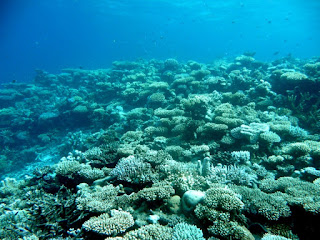Impact of El Niño Southern Oscillation on Coral Reefs
It has been well documented that rising temperatures are
causing mass bleaching of coral reefs and putting the population of coral reefs
under threat. This is partly due to anthropogenic warming, but there is a
natural phenomenon that is causing temperatures to rise. This is known as El Niño.
The idea of this is that trade winds at the equator cause ocean currents in the
East Pacific to upwell from deep in the ocean. This helps to keep the average
temperature of the East Pacific relatively cool. The current then proceeds
west. As it moves in this direction, it is heated by the sun, meaning
temperatures in the West Pacific are up to 10 degrees warmer than in the east.
When an El Niño event occurs, this current that cools the East Pacific will
significantly weaken, or may even disappear completely. This results in the
East Pacific being pretty much the same temperature as the West Pacific.
This higher ocean temperature in the East Pacific is not
good news for corals. The ENSO has been
identified as the trigger of bleaching in the Eastern Pacific. Studies in the
Java Sea have shown just how big an effect El Niño can have on coral reefs. The
1982/83 warming event meant that average sea temperature was raised by 2-3
degrees over a six month period. This rapid warming was too much for corals,
with between 80-90% of corals having died at test sites. This is obviously a
massive blow to coral population, as well as significant damage to other marine
life that lives in and around the coral. As seen in Figure 1, the Java Sea
borders Java, Sumatra and Borneo. These are all heavily reliant on tourism and
the loss of 80-90% of the areas coral reefs would have been a significant
deterrent to tourists. Five years after the study there was a recovery of
sorts, however the coral population is still at around 50% of previous levels.
Figure 1- Map of the Java Sea and surrounding area.
Gill et al. (2006) showed that high levels of aerosols (dust
and sulphides, largely created by volcanic activity) effectively mitigated
bleaching conditions, even during ENSO years that would normally have created
bleaching-favourable conditions. An El Niño event coupled with a period of
anthropogenic warming could prove catastrophic for coral reefs. Having said
this however, there have been several El Niño events since the mass bleaching
event in Indonesia without there being such a pronounced effect on the coral
population. This means that there must be other factors affecting coral reefs,
not just the ENSO. The variety of factors affecting coral reefs in the South
Pacific means that quantifying the impact of these events on coral reefs is
very difficult, however it is certain that they will be important to the future
survival of coral reefs.
Sources
